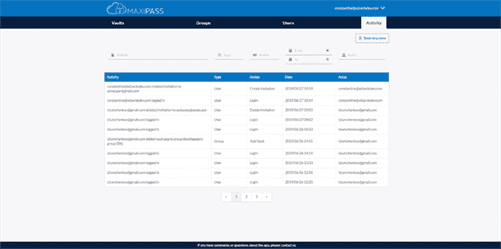You can get started creating simple tests for your application in a few easy steps and then build on it from there. Optional argument globs gives a dictionary to use as both local and global
execution context. A shallow copy of module.__dict__ is used for both local and global
execution context. This function is used internally by other functions (see below), but can also be
useful when you want to transform an interactive Python session into a Python
script.

Security testing is essential for software that processes confidential data to prevent system intrusion by hackers. You must do the first eight steps whether you use automatic test generators or do it by hand. The first eight items on this list are 50 to 75 per cent of the labour of syntax testing. Returns true if and only if the test passed (i.e. no test part failed). Gets the line in the source file where the test part took place, or -1 if it’s
unknown.
Beta testing
The SRS is also a specification, but it cannot be verified (at least not in the sense used here, more on this subject below). Sometimes such issues can be fixed by proactively abstracting operating system functionality into a separate program module or library. These types of tests are usually written by developers as they work on code (white-box style), to ensure that the specific function is working as expected. One function might have multiple tests, to catch corner cases or other branches in the code. Unit testing alone cannot verify the functionality of a piece of software, but rather is used to ensure that the building blocks of the software work independently from each other. One advantage of the black box technique is that no programming knowledge is required.
Only failures in the thread that executes the assertion are checked to determine
the result of this type of assertions. If statement creates new threads,
failures in these threads are ignored. If your application depends on data from a remote location, like a remote API, you’ll want to ensure your tests are repeatable.
What Test Strategy needs to be followed in Syntax Testing?
Returns the standard listener responsible for the default console output. Can be
removed from the listeners list to shut down default console output. Note that
removing this object from the listener list with
Release() transfers its ownership to the
caller and makes this function return NULL the next time. Calls to RecordProperty made during the lifespan of the test (from the moment
its constructor starts to the moment its destructor finishes) are output in XML
as attributes of the element. Properties recorded from a fixture’s
SetUpTestSuite or TearDownTestSuite methods are logged as attributes of the
corresponding element. Calls to RecordProperty made in the
global context (before or after invocation of RUN_ALL_TESTS or from the
SetUp/TearDown methods of registered Environment objects) are output as
attributes of the element.

Typically, this is the name
of the object or file that the test was extracted from. The namespace (aka globals) that the examples should be run in. Any changes to the namespace made by the
examples (such as binding new variables) will be reflected in globs
after the test is run. Optional argument extraglobs specifies an extra set of global variables, which
is merged into globs. A shallow copy of dictionary argument globs is used for the execution context. Optional argument name gives the name of the module; by default, or if
None, m.__name__ is used.
Typed Tests
What makes this method effective is that though any one case is unlikely to reveal a bug, many cases are used which are also very easy to design. It usually begins by defining the syntax using a formal metalanguage, of which BNF is the most popular. Once the BNF has been specified, generating a set of tests that cover the syntax graph is a straightforward matter. The need for syntax testing arises since most systems have hidden languages (a programming language that has not been recognized as such).
GTEST_ALLOW_UNINSTANTIATED_PARAMETERIZED_TEST suppresses this failure for the
given test suite. Allows the value-parameterized test suite TestSuiteName to be
uninstantiated. Similar to assertions, GTEST_SKIP allows streaming a custom message into it. Both arguments TestSuiteName and TestName must be valid C++ identifiers
and must not contain underscores (_).
TestSuite
The terms load testing, performance testing, scalability testing, syntax testing and volume testing, are often used interchangeably.
- The unittest unit testing framework was originally inspired by JUnit
and has a similar flavor as major unit testing frameworks in other
languages. - There are many frameworks[specify] to write tests in, and continuous integration software will run tests automatically every time code is checked into a version control system.
- It is applicable to any situation where the data or input has many acceptable forms and one wishes to test system that only the ‘proper’ forms are accepted and all improper forms are rejected.
- The routes, views, and models all require lots of imports and knowledge about the frameworks being used.
- The value of the unittest reporting flags in effect before the function
was called is returned by the function.
If optional argument verbose is true, output is generated even if there are no
failures. By default, output is generated only in case of an example failure. Optional arguments extraglobs, verbose, report, optionflags,
raise_on_error, and globs are the same as for function testfile()
above, except that globs defaults to m.__dict__. This means examples can
freely use any names defined at top-level in M, and names defined earlier
in the docstring being run.
Creating Value-Parameterized Abstract Tests
Normally the former is considered a better practice since it allows interface issues to be located more quickly and fixed. As we saw earlier, syntax testing is a special data-driven technique, which was developed as a tool for testing the input data to language processors such as compilers or interpreters. It is applicable to any situation where the data or input has many acceptable forms and one wishes to test system that only the ‘proper’ forms are accepted and all improper forms are rejected. Syntax testing is performed to verify and validate the both internal and external data input to the system, against the specified format, file format, database schema, protocol and other similar things. Generally, syntax tests are automated, as they involve the production of large number of tests. Syntax testing is a shotgun method that depends on many test cases.

Please note that INSTANTIATE_TEST_SUITE_P will instantiate all tests in the
given test suite, whether their definitions come before or after the
INSTANTIATE_TEST_SUITE_P statement. Then, use the TEST_P macro to define as many test patterns using this fixture
as you want. The _P suffix is for “parameterized” or “pattern”, whichever you
prefer to think. When built with Bazel and using Abseil, GoogleTest uses the
RE2 syntax. Otherwise, for POSIX
systems (Linux, Cygwin, Mac), GoogleTest uses the
POSIX extended regular expression
syntax. To learn about POSIX syntax, you may want to read this
Wikipedia entry.
Property testing
The applications and limitations specified above may prove beneficial to adopt syntax testing. The argument TestFixtureName is a fixture class template, parameterized by a
type. You can set the GTEST_COLOR environment variable or the –gtest_color
command line flag to yes, no, or auto (the default) to enable colors,
disable colors, or let GoogleTest decide. When the value is auto, GoogleTest
will use colors if and only if the output goes to a terminal and (on non-Windows
platforms) the TERM environment variable is set to xterm or xterm-color.
Isolating Behaviors in Your Application
Functions will be called in reverse
order to the order they are added (LIFO). They are called with any arguments and keyword arguments passed into
addModuleCleanup() when they are added. If an exception is raised during a setUpClass then the tests in the class
are not run and the tearDownClass is not run. Skipped classes will not
have setUpClass or tearDownClass run. If the exception is a
SkipTest exception then the class will be reported as having been skipped
instead of as an error.
The testRunner argument can either be a test runner class or an already
created instance of it. By default main calls sys.exit() with
an exit code indicating success (0) or failure (1) of the tests run. A list containing 2-tuples of TestCase instances and strings
holding formatted tracebacks. Each tuple represents a test which raised an
unexpected exception.

